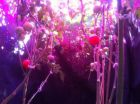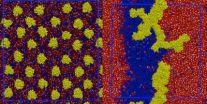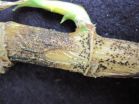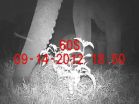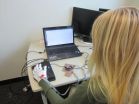(Press-News.org) QUEBEC – In Canada, where outdoor growing seasons are limited, sales from greenhouse fruit and vegetable production operations still surpass $1.1 billion annually. Finding more efficient methods for providing lighting in greenhouse production is a key component to support these high levels of production and increase revenues. "Light irradiance is the limiting factor for increasing production in greenhouses, when all other factors (temperature, nutrient levels, and water availability) are adequately maintained," said the authors of a new study. McGill University researchers Paul Deram, Mark G. Lefsrud, and Valérie Orsat said that the broad-spectrum high-pressure sodium lamps currently used to provide supplemental lighting for greenhouse are "not the most efficient light source" for greenhouse plant production. The team published the findings of their study aimed at finding alternative lighting options in HortScience.
According to the authors, specific light frequencies in the 400- to 700-nm range have previously been shown to affect photosynthesis more directly than other wavelengths (especially in the red and blue ranges). The researchers designed experiments to determine whether light-emitting diodes (LEDs) could reduce lighting costs in greenhouses. "LEDs can be selected to target the wavelengths used by plants, enabling growers to customize the light produced, to enable maximum plant production and limit wavelengths that do not significantly impact plant growth," they explained.
The scientists subjected hydroponically grown tomato plants to three light intensities at three red-to-blue ratio levels. Secondary lighting treatments used for comparison included 100% high-pressure sodium (HPS), 100% red LED light supplied from above the plant, 100% red LED light supplied below the plant, a 50%:50% LED:HPS mixture, and a control (no supplemental lighting). Both runs of the experiment were implemented for 120 days during two (summer-fall and winter-spring) seasons.
Results showed that the five highest number of fruit-producing light treatments were 5:1 high (385 fruit), 5:1 medium (358 fruit), 5:1 low (341 fruit), 19:1 high (315 fruit), and 100% LED (310 fruit). "Overall, the highest producing LED treatments consistently outperformed the high-pressure sodium treatment alone," the authors said. "These treatments can be considered an improvement over traditional HPS lighting for greenhouses."
Outcomes also revealed that high irradiance levels resulted in the highest vegetative biomass and fruit production for all ratios. The results showed that the highest biomass production (excluding fruit) occurred using the 19:1 ratio, while higher fruit production was obtained using the 5:1 ratio. The highest marketable fruit production resulted from the 50%:50% LED:HPS treatment. The authors said that the 5:1 high treatment performed well in every category.
"As expected from the literature, higher intensities bring forth more production with all ratios producing more under higher irradiance levels," Deram, Lefsrud, and Orsat said. They also determined that an increase in red light increased biomass production and slightly lowered the amount of fruit production. They concluded that LEDs are a "promising mechanism" to enhance greenhouse artificial lighting systems.
INFORMATION:
The complete study and abstract are available on the ASHS HortScience electronic journal web site: http://hortsci.ashspublications.org/content/49/4/448.abstract
Founded in 1903, the American Society for Horticultural Science (ASHS) is the largest organization dedicated to advancing all facets of horticultural research, education, and application. More information at ashs.org
Light-emitting diode treatments outperform traditional lighting methods
Specific LED treatments found more effective than high-pressure sodium lighting for greenhouse tomatoes
2014-06-23
ELSE PRESS RELEASES FROM THIS DATE:
Cancer chain in the membrane
2014-06-23
Supercomputer simulations have shown that clusters of a protein linked to cancer warp cell membranes, according to scientists at The University of Texas Health Science Center at Houston (UTHealth) Medical School. This research on these protein clusters, or aggregates as scientists call them, could help guide design of new anticancer drugs.
"The aggregate is a large substructure that imposes some kind of curvature on the membrane — that's really the major observation," said Alemayehu Gorfe, assistant professor of Integrative Biology and Pharmacology at the UTHealth Medical ...
Working parents resort to emergency or urgent care visits to get kids back into child care
2014-06-23
Ann Arbor, Mich. — Substantial proportions of parents chose urgent care or emergency department visits when their sick children were excluded from attending child care, according to a new study by University of Michigan researchers.
The study, published today in Pediatrics, also found that use of the emergency department or urgent care was significantly higher among parents who are single or divorced, African American, have job concerns or needed a doctor's note for the child to return.
Previous studies have shown children in child care are frequently ill with mild ...
Fungal infection control methods for lucky bamboo
2014-06-23
GAINESVILLE, FL – The popularity of ornamental plants imported to the United States from China is accompanied by concerns about the potential to introduce pathogens into the market. Dracaena, a genus consisting of approximately 40 different species, including the widely recognized "lucky bamboo," is among the most frequently imported group of ornamentals to enter the U.S. for domestic sale and eventual export to Canada. The authors of a new research study say it is crucial to be vigilant about potential pests and pathogens on imported cuttings of Dracaena. "Pests and pathogens ...
Cautionary tales: Mustaches, home oxygen therapy, sparks do not mix
2014-06-23
Rochester, Minn. — Facial hair and home oxygen therapy can prove a dangerously combustible combination, a Mayo Clinic report published in the peer-reviewed medical journal Mayo Clinic Proceedings finds. To reach that conclusion, researchers reviewed home oxygen therapy-related burn cases and experimented with a mustachioed mannequin, a facial hair-free mannequin, nasal oxygen tubes and sparks. They found that facial hair raises the risk of home oxygen therapy-related burns, and encourage health care providers to counsel patients about the risk.
MULTIMEDIA ALERT: Video ...
Africa's poison 'apple' provides common ground for saving elephants, raising livestock
2014-06-23
VIDEO:
A five-year study led by Robert Pringle (above), a Princeton University assistant professor of ecology and evolutionary biology, suggests that certain wild African animals, particularly elephants, could be a boon...
Click here for more information.
While African wildlife often run afoul of ranchers and pastoralists securing food and water resources for their animals, the interests of fauna and farmer might finally be unified by the "Sodom apple," a toxic invasive plant ...
Back away, please
2014-06-23
In our long struggle for survival, we humans learned that something approaching us is far more of a threat than something that is moving away. This makes sense, since a tiger bounding toward a person is certainly more of a threat than one that is walking away.
Though we modern humans don't really consider such fear, it turns out that it still plays a big part in our day-to-day lives. According to University of Chicago Booth School of Business Professor Christopher K. Hsee, we still have negative feelings about things that approach us — even if they objectively are not ...
Wearable computing gloves can teach Braille, even if you're not paying attention
2014-06-23
Several years ago, Georgia Institute of Technology researchers created a technology-enhanced glove that can teach beginners how to play piano melodies in 45 minutes. Now they've advanced the same wearable computing technology to help people learn how to read and write Braille. The twist is that people wearing the glove don't have to pay attention. They learn while doing something else.
"The process is based on passive haptic learning (PHL)," said Thad Starner, a Georgia Tech professor and wearable computer pioneer. "We've learned that people can acquire motor skills ...
Can magnetic fields accurately measure positions of ferromagnetic objects?
2014-06-23
Many creatures in nature, including butterflies, newts and mole rats, use the Earth's inherent magnetic field lines and field intensity variations to determine their geographical position. A research team at the University of Minnesota has shown that the inherent magnetic fields of ferromagnetic objects can be similarly exploited for accurate position measurements of these objects. Such position measurement is enabled in this research by showing that the spatial variation of magnetic field around an object can be modeled using just the geometry of the object under consideration. ...
Breakthrough drug-eluting patch stops scar growth and reduces scar tissues
2014-06-23
Scars — in particular keloid scars that result from overgrowth of skin tissue after injuries or surgeries — are unsightly and can even lead to disfigurement and psychological problems of affected patients. Individuals with darker pigmentation — in particular people with African, Hispanic or South-Asian genetic background — are more likely to develop this skin tissue disorder. Current therapy options, including surgery and injections of corticosteroids into scar tissues, are often ineffective, require clinical supervision and can be costly.
A new invention by researchers ...
D-Wave and predecessors: From simulated to quantum annealing
2014-06-23
The D-Wave computer is currently the latest link of a long chain of computers designed for the solution of optimization problems. In what sense does it realize quantum computation? We describe the evolution of such computers and confront the different views concerning the quantum properties of the D-wave computer.
Quantum algorithms show several benefits over classical ones. One strong example suggested by Shor in 1994 is the ability to factor numbers which can be effectively done on a quantum computer but is very hard on a classical computer. However, the actual model ...
LAST 30 PRESS RELEASES:
First Editorial of 2026: Resisting AI slop
Joint ground- and space-based observations reveal Saturn-mass rogue planet
Inheritable genetic variant offers protection against blood cancer risk and progression
Pigs settled Pacific islands alongside early human voyagers
A Coral reef’s daily pulse reshapes microbes in surrounding waters
EAST Tokamak experiments exceed plasma density limit, offering new approach to fusion ignition
Groundbreaking discovery reveals Africa’s oldest cremation pyre and complex ritual practices
First breathing ‘lung-on-chip’ developed using genetically identical cells
How people moved pigs across the Pacific
Interaction of climate change and human activity and its impact on plant diversity in Qinghai-Tibet plateau
From addressing uncertainty to national strategy: an interpretation of Professor Lim Siong Guan’s views
Clinical trials on AI language model use in digestive healthcare
Scientists improve robotic visual–inertial trajectory localization accuracy using cross-modal interaction and selection techniques
Correlation between cancer cachexia and immune-related adverse events in HCC
Human adipose tissue: a new source for functional organoids
Metro lines double as freight highways during off-peak hours, Beijing study shows
Biomedical functions and applications of nanomaterials in tumor diagnosis and treatment: perspectives from ophthalmic oncology
3D imaging unveils how passivation improves perovskite solar cell performance
Enriching framework Al sites in 8-membered rings of Cu-SSZ-39 zeolite to enhance low-temperature ammonia selective catalytic reduction performance
AI-powered RNA drug development: a new frontier in therapeutics
Decoupling the HOR enhancement on PtRu: Dynamically matching interfacial water to reaction coordinates
Sulfur isn’t poisonous when it synergistically acts with phosphine in olefins hydroformylation
URI researchers uncover molecular mechanisms behind speciation in corals
Chitin based carbon aerogel offers a cleaner way to store thermal energy
Tracing hidden sources of nitrate pollution in rapidly changing rural urban landscapes
Viruses on plastic pollution may quietly accelerate the spread of antibiotic resistance
Three UH Rainbow Babies & Children’s faculty elected to prestigious American Pediatric Society
Tunnel resilience models unveiled to aid post-earthquake recovery
Satellite communication systems: the future of 5G/6G connectivity
Space computing power networks: a new frontier for satellite technologies
[Press-News.org] Light-emitting diode treatments outperform traditional lighting methodsSpecific LED treatments found more effective than high-pressure sodium lighting for greenhouse tomatoes
